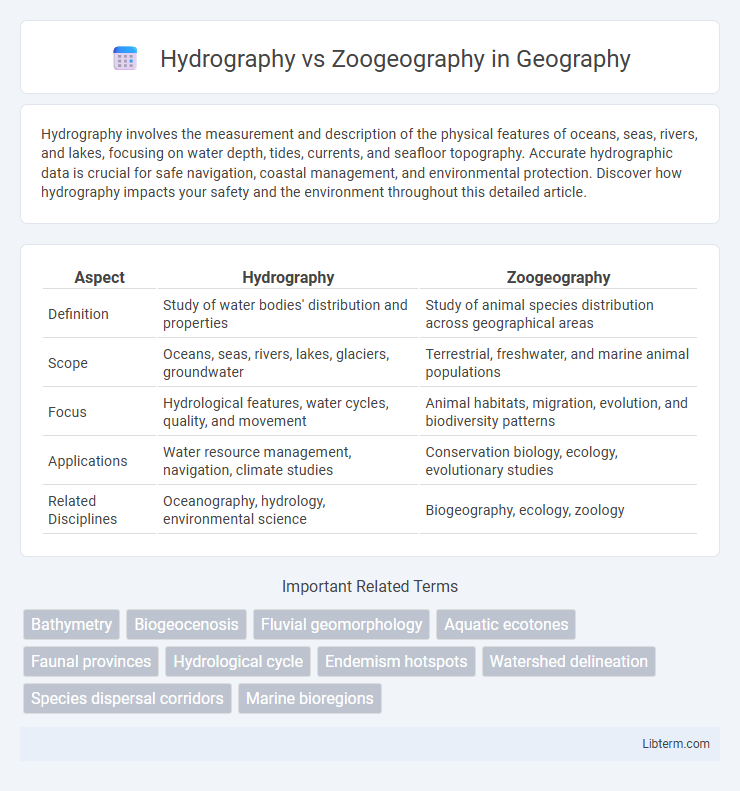Hydrography involves the measurement and description of the physical features of oceans, seas, rivers, and lakes, focusing on water depth, tides, currents, and seafloor topography. Accurate hydrographic data is crucial for safe navigation, coastal management, and environmental protection. Discover how hydrography impacts your safety and the environment throughout this detailed article.
Table of Comparison
| Aspect | Hydrography | Zoogeography |
|---|---|---|
| Definition | Study of water bodies' distribution and properties | Study of animal species distribution across geographical areas |
| Scope | Oceans, seas, rivers, lakes, glaciers, groundwater | Terrestrial, freshwater, and marine animal populations |
| Focus | Hydrological features, water cycles, quality, and movement | Animal habitats, migration, evolution, and biodiversity patterns |
| Applications | Water resource management, navigation, climate studies | Conservation biology, ecology, evolutionary studies |
| Related Disciplines | Oceanography, hydrology, environmental science | Biogeography, ecology, zoology |
Introduction to Hydrography and Zoogeography
Hydrography studies the physical characteristics, distribution, and movement of water bodies such as oceans, rivers, and lakes, emphasizing measurements related to navigation, tides, currents, and depths. Zoogeography examines the spatial distribution of animal species and populations across different ecosystems, analyzing patterns influenced by environmental factors, climate, and evolutionary history. Both fields interconnect in aquatic environments where water properties affect the distribution and behavior of aquatic fauna.
Defining Hydrography: Scope and Significance
Hydrography involves the measurement and description of physical features of oceans, seas, rivers, and lakes, focusing on water currents, depths, and tides critical for navigation and marine activities. This discipline plays a vital role in environmental monitoring, resource management, and maritime safety by providing accurate maps and data on aquatic environments. Unlike zoogeography, which studies the distribution of animal species across geographic areas, hydrography emphasizes the physical characteristics and dynamics of water bodies.
Zoogeography Explained: Patterns of Animal Distribution
Zoogeography examines the spatial distribution of animal species and populations, revealing patterns shaped by evolutionary history, climate, and habitat types. It integrates factors like continental drift, biogeographic realms, and ecological barriers to explain why certain species inhabit specific regions. In contrast, hydrography focuses on the physical characteristics and movements of water bodies, which indirectly influence zoogeographic patterns by shaping aquatic habitats.
Key Differences Between Hydrography and Zoogeography
Hydrography studies the physical characteristics and mapping of water bodies such as oceans, rivers, and lakes, focusing on aspects like water depth, tides, and currents. Zoogeography examines the distribution and habitat patterns of animal species across different geographical areas, analyzing ecological and evolutionary factors shaping these patterns. The key difference lies in hydrography's emphasis on aquatic environments and water-related phenomena, versus zoogeography's focus on animal populations and biodiversity across terrestrial and aquatic ecosystems.
Interplay Between Hydrography and Zoogeography
Hydrography, which studies the physical properties and distribution of water bodies, shapes zoogeography by influencing aquatic habitats and animal migration patterns. Variations in temperature, salinity, and water currents directly affect species distribution and biodiversity within freshwater and marine ecosystems. Understanding the interplay between hydrography and zoogeography is essential for predicting ecological responses to environmental changes and managing aquatic resources effectively.
Methods and Tools Used in Hydrography
Hydrography employs advanced tools such as multi-beam sonar systems, satellite altimetry, and GPS technology to accurately map underwater terrain and measure water depth, currents, and tides. Techniques like echo sounding and remote sensing are integral for collecting precise bathymetric data, enabling detailed seafloor characterization. In contrast, zoogeography primarily utilizes ecological surveys, species distribution modeling, and genetic analysis to study animal populations and their spatial patterns.
Research Techniques in Zoogeography
Zoogeography research techniques primarily involve species distribution mapping, spatial analysis using Geographic Information Systems (GIS), and ecological niche modeling to study animal habitats. Molecular methods such as DNA barcoding and phylogeography help trace evolutionary relationships and population structures across geographic regions. Field surveys, remote sensing, and biodiversity databases also play crucial roles in collecting and analyzing data for understanding animal biogeographic patterns.
Environmental Impacts on Hydrography and Zoogeography
Hydrography examines the physical characteristics of water bodies, including flow patterns, depth, and quality, which are directly altered by environmental factors such as climate change, pollution, and land use changes. Zoogeography studies the distribution of animal species and populations, which are profoundly influenced by shifts in hydrographic conditions, as changes in water temperature, salinity, and habitat availability impact species migration, reproduction, and survival rates. Environmental disturbances like deforestation, urbanization, and acidification disrupt both hydrographic systems and zoogeographic patterns, leading to altered ecosystems and diminished biodiversity.
Applications in Conservation and Biodiversity Management
Hydrography provides critical data on water bodies, currents, and aquatic habitats essential for aquatic conservation planning and the management of freshwater biodiversity hotspots. Zoogeography maps the distribution patterns of animal species, aiding in identifying biodiversity hotspots and prioritizing areas for wildlife protection and habitat restoration. Integrating hydrographic data with zoogeographic information enhances the effectiveness of conservation strategies by ensuring both aquatic environments and terrestrial fauna distributions are considered.
Future Trends in Hydrography and Zoogeography Studies
Future trends in hydrography emphasize the integration of advanced satellite remote sensing and autonomous underwater vehicles to enhance ocean mapping accuracy and real-time data collection. Emerging technologies in zoogeography focus on utilizing machine learning algorithms and environmental DNA (eDNA) sampling to track species distribution changes driven by climate change and habitat fragmentation. Both fields increasingly adopt interdisciplinary approaches combining big data analytics and geographic information systems (GIS) to improve ecological modeling and marine spatial planning.
Hydrography Infographic

 libterm.com
libterm.com